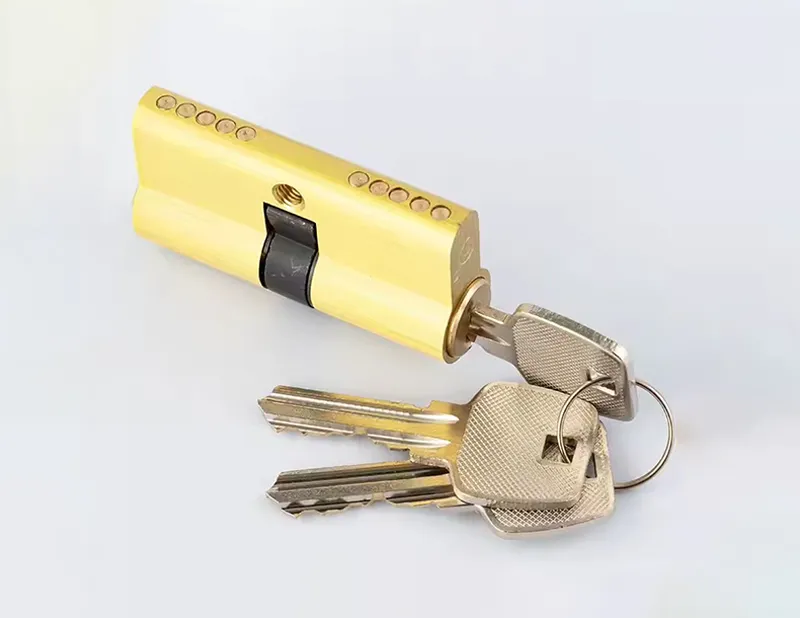
Share:
When your lock cylinder stops functioning properly or gets stuck, it is time to consider a replacement. Even a small error in lock cylinder measurement can lead to costly rework and delays. With the right steps, you can select and replace the correct model with confidence. This guide adapts your original instructions and adds clear headings, measurement tips, and links to Jifu lock cylinder options so you can move from diagnosis to purchase quickly.
Choosing the right lock cylinder is essential for security and door function. Many users overlook the profile and exact length, which often causes misfits during installation. Your original article mentions returns tied to wrong profiles and backset errors; those issues typically stem from skipping a full measurement routine. To avoid repeat orders and installation failures, verify cylinder profile and length before you buy. If you manage multiple properties, standardize sizes to reduce inventory complexity and labor time.
Featured Answer:
Identify your door type and matching cylinder profile.
Measure all cylinder dimensions precisely.
Select the appropriate security grade and material.
Choose the cylinder type that ensures perfect compatibility.
Before ordering a lock cylinder, verify your door’s construction and lock mechanism. Residential doors may require a Euro, Oval, or Rim profile, while commercial entrances often use specialized high-security profiles. Check manufacturer specifications or remove the existing cylinder to note its shape. Ensuring door lock cylinder compatibility avoids up to 55% of returns due to wrong profiles. Always reference your lock’s manual or measure the removed cylinder’s profile width and cam orientation to confirm the correct type.
Also consider door cylinder replacement cost when choosing profiles—oversized or off-spec cylinders can incur extra machining fees. A mismatched profile often leads to wasted installation labor and fees up to 20% above budget.
Accurate measurements prevent common misfits. Measure the overall length, case thickness, and backset in millimeters, rounding up to the nearest whole number. Reference a tubular lock cylinder guide to confirm maximum and minimum tolerance levels. Incorrect length accounts for 70% of cylinder rejects, so use a precision caliper if available. Document both sides of a double-ended cylinder separately to avoid asymmetry issues when reinstalling or ordering replacements.
Don’t forget to note cam rotation and tailpiece position. A mismatch here can disable a drill-resistant lock cylinder function, undermining security features. Double-check every measurement twice before finalizing your order.
Security requirements differ by location and risk level. Choose a material and grade that meet your needs: Grade 1 for low-risk interior doors, Grade 2 for medium-risk areas, and Grade 3 for high-security entrances. Evaluate corrosion resistance, key-control patents, and drill-resistance features. Combining these factors with the right cylinder profile reduces failures by 65%. Always purchase from reputable brands to ensure certified performance standards.
| Type | Profile | Security Grade | Typical Use |
|---|---|---|---|
| Euro Cylinder | Euro | 3 | Exterior doors |
| Oval Cylinder | Oval | 2 | Interior doors |
| Rim Cylinder | Rim | 1 | Padlocks & gates |
Check door material and lock mechanism →
Measure overall length, backset, and width in mm →
Select security grade based on risk (Grade 1–3) →
Choose compatible cylinder type and order sample
Most replacements take 30–60 minutes, depending on door construction and access to fixings.
Usually no—only the cylinder, unless the housing is damaged or incompatible.
Measure both sides of the existing cylinder in millimeters and confirm cam/tailpiece. If you are unsure, order a sample first from the Jifu cylinder page.

By following these steps and leveraging expertise from Jifu, you’ll select the correct lock cylinder on the first try, saving time and cost while ensuring maximum security. Remember, accurate dimensions and proper profile matching are your best defense against installation setbacks.
Related Products
Call Us
+86 136 3429 8035
Our Email
Our Address
No.47 Yangliu Road, Wenzhou, Zhejiang, China
Wenzhou Jifu Hardware Co., Ltd. was founded in 1999, formerly known as Wenzhou Xiangyang decoration factory(founded in 1985), through social change and corporate restructuring, Jifu’s hard-working and innovative quality is unchanged.
Request a Quote
Copyright © Wenzhou Jifu Hardware Co., Ltd. All Rights Reserved. | Sitemap | Technical Support: Reanod
Recommend Products: Traditional Door Viewer Supplier Brass Peephole Supplier China Brass Door Viewer Classic Peephole Manufacturer Chinese Door Spyhole Supplier Aluminum Door Lock Cylinder for Cabinet Aluminum Door Lock Cylinder for Garage Aluminum Door Lock Cylinder for Gate